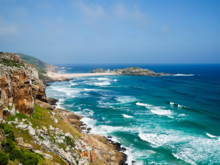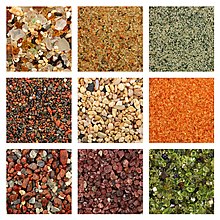Beach
The particles composing a beach are typically made from rock, such as sand, gravel, shingle, pebbles, etc., or biological sources, such as mollusc shells or coralline algae.Sediments settle in different densities and structures, depending on the local wave action and weather, creating different textures, colors and gradients or layers of material.At the very bottom of the face, there may be a trough, and further seaward one or more long shore bars: slightly raised, underwater embankments formed where the waves first start to break.The gentle wave action during this season tends to transport sediment up the beach towards the berm where it is deposited and remains while the water recedes.Established vegetation (especially species with complex network root systems) will resist erosion by slowing the fluid flow at the surface layer.Coastlines facing very energetic wind and wave systems will tend to hold only large rocks as smaller particles will be held in suspension in the turbid water column and carried to calmer areas by longshore currents and tides.Sediment that remains in suspension when the following wave crest arrives will not be able to settle and compact and will be more susceptible to erosion by longshore currents and receding tides.During hot calm seasons, a crust may form on the surface of ocean beaches as the heat of the sun evaporates the water leaving the salt which crystallises around the sand particles.Erosion of beaches can expose less resilient soils and rocks to wind and wave action leading to undermining of coastal headlands eventually resulting in catastrophic collapse of large quantities of overburden into the shallows.This material may be distributed along the beach front leading to a change in the habitat as sea grasses and corals in the shallows may be buried or deprived of light and nutrients.Beachfront flora plays a major role in stabilizing the foredunes and preventing beach head erosion and inland movement of dunes.While the destruction of flora may be a gradual process that is imperceptible to regular beach users, it often becomes immediately apparent after storms associated with high winds and freak wave events that can rapidly move large volumes of exposed and unstable sand, depositing them further inland, or carrying them out into the permanent water forming offshore bars, lagoons or increasing the area of the beach exposed at low tide.If the flow is constant, runoff from cleared land arriving at the beach head will tend to deposit this material into the sand changing its color, odor and fauna.If the runoff is naturally dispersed along the beach, water borne silt and organic matter will be retained on the land and will feed the flora in the coastal area.In extreme cases, beach nourishment may involve placement of large pebbles or rocks in an effort to permanently restore a shoreline subject to constant erosion and loss of foreshore.Later, Queen Victoria's long-standing patronage of the Isle of Wight and Ramsgate in Kent ensured that a seaside residence was considered as a highly fashionable possession for those wealthy enough to afford more than one home.The extension of this form of leisure to the middle and working classes began with the development of the railways in the 1840s, which offered cheap fares to fast-growing resort towns.In particular, the completion of a branch line to the small seaside town of Blackpool from Poulton led to a sustained economic and demographic boom.[10] The growth was intensified by the practice among the Lancashire cotton mill owners of closing the factories for a week every year to service and repair machinery.Each town's mills would close for a different week, allowing Blackpool to manage a steady and reliable stream of visitors over a prolonged period in the summer.[13] Continental European attitudes towards gambling and nakedness tended to be more lax than in Britain, so British and French entrepreneurs were quick to exploit the possibilities.By the 1970s cheap and affordable air travel led to the growth of a truly global tourism market which benefited areas such as the Mediterranean, Australia, South Africa, and the coastal Sun Belt regions of the United States.In most countries social norms are significantly different on a beach in hot weather, compared to adjacent areas where similar behavior might not be tolerated and might even be prosecuted.Some beaches are artificial; they are either permanent or temporary (For examples, see Copenhagen, Hong Kong, Manila, Monaco, Nottingham, Paris, Rotterdam, Singapore, Tianjin, and Toronto).The Surfrider Foundation has debated the merits of artificial reefs with members torn between their desire to support natural coastal environments and opportunities to enhance the quality of surfing waves.Allowing random access across delicate foredunes is seldom considered good practice as it is likely to lead to destruction of flora and consequent erosion of the fore dunes.Concrete ramps and steps should be maintained to prevent a buildup of moss or algae that may make their wet surfaces slippery and dangerous to pedestrians and vehicles.If the corduroy is not wide enough for vehicles using it, the sediment on either side may be displaced creating a spoon drain that accelerates surface runoff and can quickly lead to serious erosion.Significant erosion of the sediment beside and under the corduroy can render it completely ineffective and make it dangerous to pedestrian users who may fall between the planks.Fabric ramps are commonly employed by the military for temporary purposes where the underlying sediment is stable and hard enough to support the weight of the traffic.








glass, dune, quartz
volcanic, biogenic coral, pink coral
volcanic, garnet, olivine














Beach (disambiguation)Sand Beach (disambiguation)Fort Lauderdale, FloridaTrentino-Alto Adigeshinglelandformgravelpebblesbiologicalmollusc shellscoralline algaeweatherriverscurrentdepositsErosionwave actionextreme weather eventscoastal dunesdue to climate changerecreationtourismlifeguardchanging roomsshackshospitalitywater pollutionplastic pollutioncoastal erosionsea level riseclimate changecoastal managementbeach nourishmentMarine debrisHawaiiimportant biomessea turtlesseabirdspenguinsextremely high tideswrack lineinorganic debrissand dunesseashorewavelengthhigher energycoastal floodingBeach evolutionQuartzsilicagradedcurrentssedimentssuspensionsaltationslumpingcoral reeforganic matterCoastlinesmud flatsmangrovewave crestslongshore currentspebblepercolationcrystallisesshorelineslimestonescattersfeldspargypsumSouthern EuropeMediterranean BasinTunisiacalcium carbonatecoralsmollusksBermudaBahama Islandsvolcanic rockbasaltobsidianPunaluu BeachMadeiraPraia FormosaFuerteventuraSantoriniPrince Edward IslandRamla BaySardiniaolivinePapakolea Beachcarbon sequestrationProject VestaHyams Beach, New South WalesCastelldefelsCarters BeachsandspitCroatiaGalápagos IslandsLa DigueSeychellesLlandudnoAmalfi CoastBarcolaScarboroughYorkshirebathing machinesBrightonroyal patronageKing George IVLondonromanticJane AustenSanditonQueen VictoriaIsle of WightRamsgateBlackpoolPromenaderailwaysbranch linePoultoncotton millwakes weekspleasure piers

